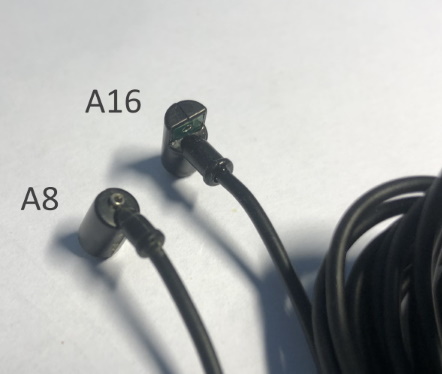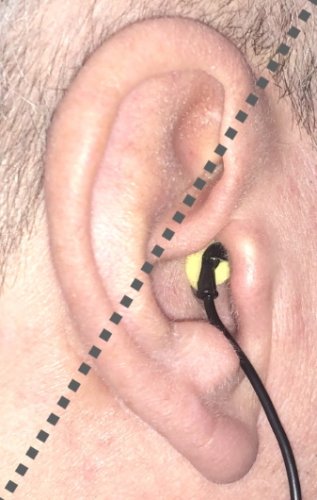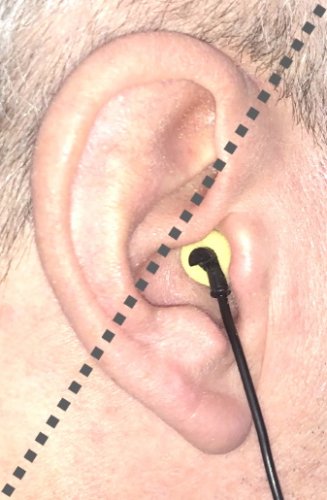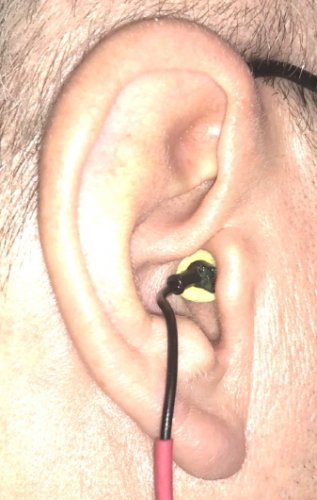Rene Lou
Head-Fier
- Joined
- Jan 21, 2014
- Posts
- 50
- Likes
- 65
About optimal A16 microphone placement in your ear canal and the A8 & A16 microphone types:
The A8 microphone is placed central at the top of a plastic cylinder. The plastic cylinder has to be inserted into your ear canal and the tiny microphone opening (small hole) was facing away from you. As a result, rotating the microphone cylinder in your ear canal had no effect in terms of PRIR capturing performance. Picture from the A8 manual:

The new A16 microphones are different and have a tiny microphone opening looking towards the attached cable:


In the A16 manual there is a picture about a "correct" A16 microphone placement:

This picture looks like if you would not have to put the microphones fully in your ear canal (which is not correct and will result in sub-optimal A16 performance - at least for my ears in terms of sound localization capabilities).
I made several tests with A16 microphone placements as following:
Initially, I captured my large stereo speakers with microphones fully inserted into the ear canal and with a similar microphone orientation as on the picture in the A16 v0.9 manual (microphone cable leaves downwards and the tiny microphone opening faces the floor):

The resulting PRIR with the corresponding autoEQ HPEQ sounded much to bright. After I made a manSPK HPEQ, the brightness was gone and the sound was more natural and in a way similar to my stereo speakers, but still not an exact copy of the speakers in terms of localization performance (eg: when playing some music, instruments were not positioned in the room exactly as when my speakers were playing - the speakers did span a deeper 3D-like room in front of me).
So I tried a different microphone placement, more similar as shown on the picture in the current v0.9 manual:

The resulting PRIR with the corresponding autoEQ HPEQ sounded still to bright. After I made a manSPK HPEQ, the brightness was gone again and the sound was more natural and in a way similar to my stereo speakers, but this time the localization performance was even worse: listening to music with the A16 sounded still out of my head, but this time much closer to me compared to when the speakers were playing the same music. This was not satisfying since I knew what the A8 was capable of and what I was looking for with the A16 as well.
So I tried the following: inserting the microphones fully into the ear canal again, but this time rotating them by approx. 90 degrees in a way that the tiny microphone opening is looking towards the rear:

Success ! The result is absolutely convincing ! The PRIR with the autoEQ HPEQ was still to bright initially as well, but after doing the manSKP HPEQ routine the A16 is now a perfect copy of my speakers. Eg: When a saxophone in a given music is located at approx. 1m behind and 0.5m towards the right of the front left speaker, the result with the A16 is exactly the same - it is an exact copy!
At least for my ears, this finally worked perfectly. So I did a full 9.1.6ch PRIR with my stereo speakers (as I have explained in a posting earlier in this thread) and did the autoEQ HPEQ and the manSPK HPEQ routines. The sound imaging of the virtual L+R speakers compared with my real speakers is identical. I used several well known music tracks to compare the A16 performance with the real speakers and have now a true copy of my speakers in the HD800 !
Maybe you want to give it a try as well: to rotate the microphones and do some tests with your own ears.
Some remarks:
I tested if I can hear any differences in performance with the Sweep types "12 sec" (single frequency sweeps per channel) and "12sec overlap" (frequency sweeps overlapping, means the right channel sweep starts already when the left channel sweep is still active in higher frequency regions). Result: No difference at all and the 12 sec overlap sweeps are much quicker. The resulting PRIR files are identical to listen to. So the 12 sec overlap sweeps can be used without any negative impact - that is an additional improvement vs. the A8.
Making the manSPK HPEQ with the HD800: Be aware that even a tiny different placement of the headphone on your head can have a big impact in terms of needed correction - especially for higher frequencies of the test. So be careful not to correct to much in the higher frequency bands just because of non-optimal headphone placement.
And finally: I think the autoEQ routine could be improved so that the mid/high frequencies do not need such a big correction with the manSPK afterwards. Just doing autoEQ - at least for my ears - sounds always to bright.
The A16 is an incredible device !
The A8 microphone is placed central at the top of a plastic cylinder. The plastic cylinder has to be inserted into your ear canal and the tiny microphone opening (small hole) was facing away from you. As a result, rotating the microphone cylinder in your ear canal had no effect in terms of PRIR capturing performance. Picture from the A8 manual:

The new A16 microphones are different and have a tiny microphone opening looking towards the attached cable:


In the A16 manual there is a picture about a "correct" A16 microphone placement:

This picture looks like if you would not have to put the microphones fully in your ear canal (which is not correct and will result in sub-optimal A16 performance - at least for my ears in terms of sound localization capabilities).
I made several tests with A16 microphone placements as following:
Initially, I captured my large stereo speakers with microphones fully inserted into the ear canal and with a similar microphone orientation as on the picture in the A16 v0.9 manual (microphone cable leaves downwards and the tiny microphone opening faces the floor):

The resulting PRIR with the corresponding autoEQ HPEQ sounded much to bright. After I made a manSPK HPEQ, the brightness was gone and the sound was more natural and in a way similar to my stereo speakers, but still not an exact copy of the speakers in terms of localization performance (eg: when playing some music, instruments were not positioned in the room exactly as when my speakers were playing - the speakers did span a deeper 3D-like room in front of me).
So I tried a different microphone placement, more similar as shown on the picture in the current v0.9 manual:

The resulting PRIR with the corresponding autoEQ HPEQ sounded still to bright. After I made a manSPK HPEQ, the brightness was gone again and the sound was more natural and in a way similar to my stereo speakers, but this time the localization performance was even worse: listening to music with the A16 sounded still out of my head, but this time much closer to me compared to when the speakers were playing the same music. This was not satisfying since I knew what the A8 was capable of and what I was looking for with the A16 as well.
So I tried the following: inserting the microphones fully into the ear canal again, but this time rotating them by approx. 90 degrees in a way that the tiny microphone opening is looking towards the rear:

Success ! The result is absolutely convincing ! The PRIR with the autoEQ HPEQ was still to bright initially as well, but after doing the manSKP HPEQ routine the A16 is now a perfect copy of my speakers. Eg: When a saxophone in a given music is located at approx. 1m behind and 0.5m towards the right of the front left speaker, the result with the A16 is exactly the same - it is an exact copy!
At least for my ears, this finally worked perfectly. So I did a full 9.1.6ch PRIR with my stereo speakers (as I have explained in a posting earlier in this thread) and did the autoEQ HPEQ and the manSPK HPEQ routines. The sound imaging of the virtual L+R speakers compared with my real speakers is identical. I used several well known music tracks to compare the A16 performance with the real speakers and have now a true copy of my speakers in the HD800 !
Maybe you want to give it a try as well: to rotate the microphones and do some tests with your own ears.
Some remarks:
I tested if I can hear any differences in performance with the Sweep types "12 sec" (single frequency sweeps per channel) and "12sec overlap" (frequency sweeps overlapping, means the right channel sweep starts already when the left channel sweep is still active in higher frequency regions). Result: No difference at all and the 12 sec overlap sweeps are much quicker. The resulting PRIR files are identical to listen to. So the 12 sec overlap sweeps can be used without any negative impact - that is an additional improvement vs. the A8.
Making the manSPK HPEQ with the HD800: Be aware that even a tiny different placement of the headphone on your head can have a big impact in terms of needed correction - especially for higher frequencies of the test. So be careful not to correct to much in the higher frequency bands just because of non-optimal headphone placement.
And finally: I think the autoEQ routine could be improved so that the mid/high frequencies do not need such a big correction with the manSPK afterwards. Just doing autoEQ - at least for my ears - sounds always to bright.
The A16 is an incredible device !
Last edited:
















